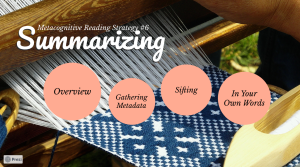22 Summarizing
Learning Objectives
-
Appropriately paraphrase and summarize texts.
-
Evaluate arguments in a text, including the validity of the reasoning, and the relevance and sufficiency of the evidence.
Chapter & Discussion
This chapter includes a presentation that can be navigated in a classroom setting or independently. You can access the presentation via the link below.
Work through the different sections of the chapter and discuss ideas and topics as they arise. If you’re working independently, take notes instead. Notes and active discussion will be helpful in navigating this week’s assignments.
Overview
Our next metacognitive reading strategy is summarizing what you’ve read. This is a powerful way to improve overall comprehension of text.
The ability to summarize information requires readers to sift through large units of text, figure out what’s important, and then create a new text that reflects only the important information. This is a difficult task. When you do it, you are practicing and strengthening the toughest comprehension skills.
Today, we’ll discuss three steps for summarizing effective:
- Gathering metadata
- Sifting out key information
- Putting ideas into your own words

Gathering Metadata
The first step in effective summarizing is to gather as much metadata as you can about the text. This means getting information about the nature and structure of the text. Before you start summarizing, you will want to know:
- Is this reading for information or literature?
- What type of writing is this? What are its basic goals?
- Will this text have keywords, topic sentences, or bold terms?
You will also need to think about the levels of this text. You should be gathering information about:
- Individual sentences
- Each paragraph
- The text as a whole
Sifting
The next step is to sort the information so that you know what’s most important. The most effective way to do this is to consider what is the main idea and what is supporting details.
You’ll need to consider what each sentence is trying to accomplish. You can ask yourself questions like:
- What is the author trying to convey?
- If there were one main takeaway, what would it be?
- How would I teach this to someone else?
Once you’ve separated the main idea from the supporting details, decide which of those are key details, ones that are best at supporting the main idea. You also want to set aside details that are less important.

In your Own Words
The hardest part of summarizing is putting ideas into your own words. However, this is also the most rewarding part of the process, as it creates new neural-pathways and greatly assists with your comprehension of a text.
- Consider the main ideas and supporting details
- Make a bulleted list in short-hand of the bare minimum of information someone would need to understand this passage
- Think about synonyms for some of the vocabulary introduced in the text
- For each item, try to find different words and phrases that could convey the same thing
- Read your summary and double check that it makes sense and covers everything you wanted to cover
Assigned Reading
Here are this week’s readings. Additionally, please read for your own personal enjoyment for 1/2 hour each day. This will be called your “Reading Zone” reading and it will coincide with many upcoming activities.
Reading Assignments by Thomas Frank (via Crash Course)
Problem Set: Practice Your Skills!
Click here to complete a ten-question problem set on concepts in this chapter.
Completing problem sets like this can be an important element of independent study towards completing your HSE. I write these to resemble the style of questions you’ll find on the Reading and Language Arts GED.
Assignment: Summarizing Arguments (250 Words)
Look over the following document: GED Extended Response Prompts. Each prompt comes in a set of two opposing viewpoints on a topic.
Select one of these prompts. Instead of responding to the prompt, create a summary of each article/viewpoint. Your summaries should each be 125 words and cover everything the audience needs to know to understand the author’s arguments.
Assignment: Reading Zone Response (250 Words)
For Reading Zone, you must find a novel that is interesting to you and enjoyable to read. If you need help finding a Reading Zone book, please ask. Please read your Reading Zone book for a half-hour each day. On class days, there will be time in class dedicated to reading.
Create a two-paragraph response to the reading you did this week. The first paragraph should summarize what you read this week. The second paragraph should address the following prompt:
Look over your summary. Based on your work, does the audience have what they need to understand what’s going on in your book? Does your summary hint at any major themes or reveal information that could help the audience get a feel for the style or tone of your book? What else might your summary need?
Attributions
Duke, N. K., & Pearson, P. D. (2002). Effective practices for developing reading comprehension. In A. E. Farstrup & S. J. Samuels (Eds.), What research has to say about reading instruction (3rd ed) (pp. 205-242). Newark, DE: International Reading Association. Reprinted in Journal of Education, 189, 107-122.
Mills, Kathy A. (2008) The Seven Habits of Highly Effective Readers. In Proceedings Stories, Places, Spaces: Literacy and Identity, National conference by the Australian Literacy Educators’ Association (ALEA) and Australian Association for the Teaching of English, Adelaide, SA.


